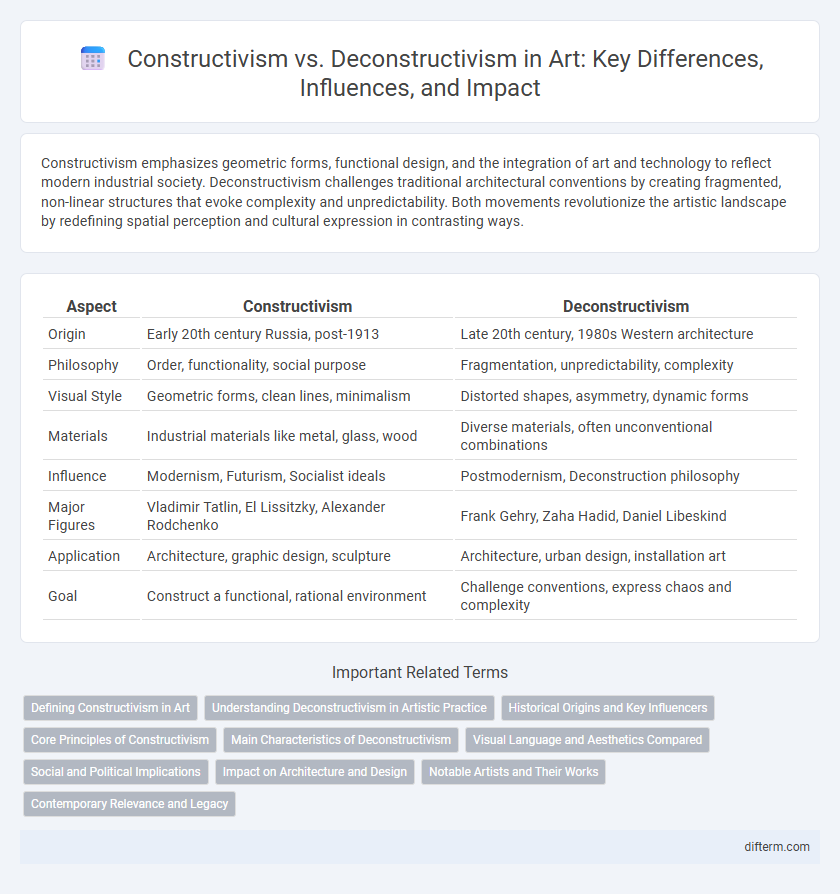Constructivism emphasizes geometric forms, functional design, and the integration of art and technology to reflect modern industrial society. Deconstructivism challenges traditional architectural conventions by creating fragmented, non-linear structures that evoke complexity and unpredictability. Both movements revolutionize the artistic landscape by redefining spatial perception and cultural expression in contrasting ways.
Table of Comparison
| Aspect | Constructivism | Deconstructivism |
|---|---|---|
| Origin | Early 20th century Russia, post-1913 | Late 20th century, 1980s Western architecture |
| Philosophy | Order, functionality, social purpose | Fragmentation, unpredictability, complexity |
| Visual Style | Geometric forms, clean lines, minimalism | Distorted shapes, asymmetry, dynamic forms |
| Materials | Industrial materials like metal, glass, wood | Diverse materials, often unconventional combinations |
| Influence | Modernism, Futurism, Socialist ideals | Postmodernism, Deconstruction philosophy |
| Major Figures | Vladimir Tatlin, El Lissitzky, Alexander Rodchenko | Frank Gehry, Zaha Hadid, Daniel Libeskind |
| Application | Architecture, graphic design, sculpture | Architecture, urban design, installation art |
| Goal | Construct a functional, rational environment | Challenge conventions, express chaos and complexity |
Defining Constructivism in Art
Constructivism in art emerged in early 20th-century Russia as an avant-garde movement emphasizing abstraction, geometric forms, and the integration of art into everyday life through functional design. It prioritizes materials, industrial aesthetics, and the creation of art with a social purpose, often rejecting traditional artistic individuality in favor of collective experience. Key artists such as Vladimir Tatlin and Alexander Rodchenko pioneered techniques that focus on construction and spatial relationships.
Understanding Deconstructivism in Artistic Practice
Deconstructivism in artistic practice challenges traditional structures by emphasizing fragmentation, non-linear narratives, and the instability of meaning, contrasting sharply with the order and clarity sought in Constructivism. Artists working within Deconstructivism often manipulate architectural forms and visual language to disrupt coherence and provoke critical reflection on cultural and social constructs. This approach fosters a dynamic interaction between artwork and viewer, encouraging continuous reinterpretation and questioning of established aesthetic norms.
Historical Origins and Key Influencers
Constructivism emerged in early 20th-century Russia, pioneered by artists like Vladimir Tatlin and Aleksandr Rodchenko, emphasizing geometric abstraction and functional design to reflect modern industrial society. Deconstructivism originated in the late 1980s as an architectural movement inspired by philosopher Jacques Derrida's ideas, with key influencers including architects Frank Gehry and Zaha Hadid challenging conventional forms through fragmented, non-linear structures. Both movements revolutionized their respective fields by rejecting traditional aesthetics, but Constructivism focused on clarity and social purpose while Deconstructivism embraced complexity and unpredictability.
Core Principles of Constructivism
Constructivism in art emphasizes geometric abstraction, functionalism, and the integration of art with social purposes, promoting art as a practice for construction and universal communication. It rejects decorative aesthetics, focusing instead on materiality and spatial presence to reflect modern industrial society. Core principles include the use of simple forms, primary colors, and an emphasis on the artwork's relationship with space and viewer interaction.
Main Characteristics of Deconstructivism
Deconstructivism in art emphasizes fragmentation, non-linear processes, and the distortion of forms to challenge traditional architectural conventions. It often features irregular shapes, unpredictable angles, and a sense of controlled chaos to disrupt harmony and symmetry. This style rejects uniformity, creating dynamic structures that evoke complexity and ambiguity.
Visual Language and Aesthetics Compared
Constructivism emphasizes geometric forms, clear structure, and functional aesthetics rooted in Soviet-era ideology, utilizing visual language that promotes order and social purpose. Deconstructivism disrupts architectural norms through fragmented, non-linear visuals and asymmetry, creating a chaotic aesthetic that challenges traditional coherence. Both styles manipulate form and space but diverge significantly in their approach to visual clarity versus complexity.
Social and Political Implications
Constructivism in art and architecture emerged in early 20th-century Russia, promoting social and political ideals of collectivism, industrial progress, and the building of a new socialist society. Deconstructivism, appearing in the late 20th century, challenges established structures and narratives, reflecting postmodern skepticism toward authority and social coherence. The contrasting movements reveal shifting attitudes toward power, identity, and cultural ideology, with Constructivism advocating order and unity, while Deconstructivism emphasizes fragmentation and critique of hegemonic social structures.
Impact on Architecture and Design
Constructivism influenced architecture by promoting functional, geometric forms and emphasizing social purpose, which led to streamlined designs with clear structural logic. Deconstructivism challenged traditional aesthetics, introducing fragmented, non-linear shapes that disrupted conventional spatial order and created dynamic, unpredictable structures. The contrasting approaches shifted architectural design paradigms, with Constructivism focusing on utility and order, and Deconstructivism embracing complexity and visual chaos.
Notable Artists and Their Works
Constructivism, exemplified by artists such as Vladimir Tatlin and El Lissitzky, emphasizes geometric abstraction and industrial materials, with Tatlin's "Monument to the Third International" and Lissitzky's "Proun" series as iconic works. In contrast, Deconstructivism, associated with architects and artists like Frank Gehry and Zaha Hadid, challenges traditional forms through fragmented, non-linear designs, as seen in Gehry's Guggenheim Museum Bilbao and Hadid's MAXXI Museum. Both movements fundamentally reshape artistic and architectural aesthetics by disrupting conventional structures and embracing innovative visual paradigms.
Contemporary Relevance and Legacy
Constructivism's emphasis on geometric abstraction and functional design continues to influence contemporary architectural and graphic design, promoting clarity and social utility. Deconstructivism challenges traditional forms through fragmentation and unpredictability, inspiring innovative structures that reflect complexity and interpretive freedom. Both movements shape modern creativity by balancing order and chaos, leaving a lasting impact on art, architecture, and visual culture.
Constructivism vs Deconstructivism Infographic

 difterm.com
difterm.com